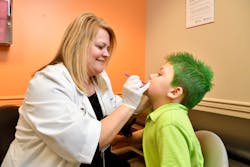Preventive oral health in the pediatric primary care setting
Dental decay is the number one chronic childhood disease, yet preventive care often is viewed as secondary. Nationally, cavities are present in more than one-quarter of preschool-age children. Cavities can cause difficulty chewing, unnecessary pain, and a lack of self-confidence.
Of children ages six to 12 across the country, 31% were reported to have missed at least half a day of school due to dental decay or other dental issues. With decay being one of few diseases that are completely preventable, it is time to begin integrating oral health into primary care to change public perception and lower a child’s susceptibility to decay.
In Kentucky, Delta Dental, in partnership with Kentucky Youth Advocates and the University of Louisville School of Dentistry, completed two studies in 2001 and 2016 that showed decay rates continuing to increase—even though children had access to dental providers and dental insurance. Of children in third and sixth grades across Kentucky, 41% were found to have untreated decay. Community leaders, including public health advocates and dental professionals, came together to find new innovative solutions that would help break this cycle and bring oral health awareness to the public. Norton Children’s Prevention & Wellness was chosen to implement changes within their system and hopefully create a lasting impression on the community.
Norton Children’s Prevention & Wellness is under the umbrella of Norton Healthcare, a regional health-care system in Louisville, Kentucky, that has multiple hospitals and providers, including 21 pediatric primary care offices. With such a wide reach and the ability to directly impact approximately 20,000 children annually, the core team created a plan that would integrate preventive oral health practice into their primary care offices. This included:
- applying fluoride varnish at wellness checks from the emergence of the first tooth through age five, as recommended by the American Academy of Pediatrics;
- educating both the child and caregiver throughout their appointment; and
- giving a referral to a dental office that was both trusted and at a close distance to the child’s home address for ease of transportation.
I was hired to spearhead the project and train staff as a project coordinator. I have been a dental hygienist for seven years working in family practice. Hiring a dental hygienist to oversee the project—as dental hygienists are known to be avid educators—and having someone with experience in oral health was important in order to see that protocol was met. Fluoride varnish integration began with training all staff, including providers, nurses, and medical assistants on the decay process and how to apply fluoride. The trainings began with watching the Smiles for Life fluoride video, a free online continuing medical education course that is part of an entire oral health curriculum. I then reviewed key points for application of fluoride, discussed integration into the primary care office, and went over oral health tips to give caregivers at the wellness check. Wellness checks are a natural place to incorporate fluoride varnish due to the preventive aspect of the appointment.
At the time of fluoride application, the child is referred to a dental office. With the help of an online program called Healthify, Norton Healthcare was able to create an inclusive network between its primary care offices and select pediatric dental offices, which would allow referrals to be shared between them. This allowed patient tracking and holding caregivers more accountable. Nineteen dental offices were selected with the guidance of the Louisville Dental Society, with locations taken into consideration. Offices were chosen in high patient populations and close to the pediatric primary care offices. Healthify allowed providers to search for a resource closest to the patient’s ZIP code, so that transportation issues can be alleviated.
Giving dental referrals is an extremely important aspect of the project. Decay can begin as soon as the first tooth erupts, typically around six months of age. Norton Healthcare is advising parents to take children to see a dentist by age one, as recommended by the American Academy of Pediatrics. These early visits help to educate caregivers on home-care regimens, lower decay rates, and alleviate a child’s fear of going to the dental office.
Children who do not go to the dentist are more likely to have tooth decay, and a child’s first visit should not be for dental pain. By taking the child preventively at an early age, he or she can become accustomed to the dental office and not view it as a place to fear.
Staff trainings ended in May 2019, and 20 pediatric practices have bega implementing the aforementioned recommendations into their daily practice. The project has been well received by both staff and caregivers. The expected outcomes include getting more children into dental homes and for decay rates to begin to decline in the Louisville area. I am excited to begin analyzing data as it comes in and to see the full impact this project will have.
Finding creative solutions to address oral health awareness in pediatric primary care should become a standard of care. Dental health is an important aspect of overall health and needs to be addressed not just in a dental office but also in the primary care office. By doing this, we are sending a unified message to caregivers to make their child’s oral health just as much of a priority as their physical health. This will ultimately lower decay rates and keep children healthier, which is always the ultimate goal.
As dental hygienists, preventive health is inherently part of our job. We are naturally patient advocates. It is important to find ways to bring awareness to dental-related issues in our community to both shift public perception and to establish that oral health is vital to a person’s well-being.
Author's note: Photos used with permission
Sources
- http://www.mychildrensteeth.org/assets/2/7/ECCstats.pdf. Accessed 31 January 2019.
- https://www.dentistrytoday.com/news/industrynews/item/315-31-of-kids-miss-school-due-to-dental-problems. Accessed 31 January 2019.
- https://www.dentistrytoday.com/news/industrynews/item/1636-study-ranks-the-states-with-the-best-and-worst-oral health?highlight=WyJzdGF0ZXMiLCJzdGF0ZXMnIl0. Accessed 31 January 2019.
- https://eclkc.ohs.acf.hhs.gov/sites/default/files/pdf/understanding-why-baby-teeth-important.pdf. Accessed 31 January 2019.
- https://www.kentuckyoralhealth.com/. Accessed 31 January 2019.
- https://www.aap.org/en-us/about-the-aap/aap-press-room/pages/AAP-Recommends-Fluoride-to-Prevent-Dental-Caries.aspx. Accessed 31 January 2019.
- https://smilesforlifeoralhealth.org/buildcontent.aspx?pagekey=101563&lastpagekey=101554&userkey=14439648&sessionkey=4691963&tut=555&customerkey=84&cust. Accessed 31 January 2019.
- https://www.healthify.us/about-us. Accessed 31 January 2019.
- https://nortonchildrens.com/news/childrens-dental-care/. Accessed 31 January 2019.
Angelina Garman, RDH, is a registered dental hygienist and project coordinator for Norton Children’s Prevention & Wellness.
About the Author
Angelina Garman, RDH
Angelina Garman, RDH, is a dental hygienist and project coordinator at Norton Children’s Prevention & Wellness.


